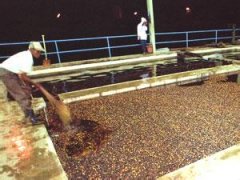Coffee beans and coffee trees varieties of coffee trees
Usually when a farm chooses which kind of coffee to grow, the first consideration is the yield and the ability to resist diseases and insect pests. Then the quality of the coffee will be considered. But now the coffee market is developing faster, and the market also needs better coffee, so if you find a way to grow high-quality coffee, you may sell it at a good price. In particular, some coffee enterprises and individuals (for example, Italian coffee companies in Puerto Rico and Australians in Indonesia) go to coffee growing countries to personally participate in the cultivation and processing of coffee. They will try to improve the quality of coffee by selecting good varieties and better processing equipment and technology.
It is generally believed that bourbon coffee and Tibica coffee are two basic varieties of Arabica coffee. As a result, many varieties have been developed.
The common ones in the market now include the following
Typica, Tibica
This is the most basic variety of Arabica coffee, and many varieties are derived from it. This kind of coffee tree is 3.5-4 meters high and the yield is very low, but the coffee tastes very good.
Bourbon, bourbon
The output of bourbon coffee is 20-30% higher than that of Tiebika coffee, but lower than that of other kinds of coffee. This kind of coffee tree has wide leaves and curved surroundings. The fruit of this kind of coffee tree is relatively small and hard. Fruit falls easily in strong wind or rain. The most suitable growing area is 1200-2200 meters above sea level. The coffee tastes excellent, similar to Tibica coffee.
Mundo Novo, Mondo Novo
This is the grafted variety of Tibica coffee and bourbon coffee, which was first found in Brazil. The variety is sturdy and resistant to diseases and insect pests, and its yield is high, but its maturity is slightly later than that of other varieties. The altitude suitable for growing areas is 1170-1800 meters, and the rainfall is 1200-1800 mm.
Maragogype, Marago Rippi (commonly known as "elephant bean")
This is a variant of bourbon coffee, first found in Brazil. The tree is stout and taller than bourbon and Tibica. But the yield is low and the coffee beans are very large. It is suitable to grow in the area of 660-830 meters above sea level. It is very popular in some markets.
Amarello, Amarero
This variety of coffee fruit is yellow and is not widely planted.
Caturra, Kaddura
This is a variant of bourbon coffee found in Brazil. This kind of coffee is of high yield and good quality, but requires careful maintenance and nutrition. Similar to bourbon coffee, this breed of coffee has broad leaves and curved edges. It is suitable for planting in a variety of environments, but it works best in areas with an altitude of 500-1830 meters and an annual rainfall of 2500-3500 mm. If the altitude is higher, the quality will be better, but the output will be reduced.
Catimor, Katimer.
It was grafted with Timor coffee and Kaddura coffee in Portugal in 1959, and the yield is very high, equal to or even higher than all commercial varieties.
Catuai, Kaduai
This is a combination of Mondonovo coffee and Kaddura coffee with a high yield. The fruit of this kind of coffee tree is not easy to fall, so it is suitable for planting in windy and rainy areas. Need more maintenance and nutrition.
Kents, Kent
This variety of coffee is widely cultivated because of its high yield and resistance to coffee leaf rust.
These are mainly different varieties of coffee grown in Arabica, and some are a series of coffee trees grown in Arabica and Canifra. There are many others, not to list one by one.
The concept of "variety" introduced above seems to be very unfamiliar. Why are these names seldom heard of? That is because coffee beans belong to crops and are highly dependent on the soil, climate, maintenance and other conditions of the region. The difference in taste between different varieties is not obvious enough, and it is always affected by the area under cultivation. That is to say, if the same variety of coffee is grown in different regions, the taste of coffee is different. Therefore, a simple distinction between varieties is of no practical significance to understand the taste of coffee. So when talking about a certain kind of coffee, first of all, distinguish between Arabica coffee and Robaster coffee; second, when distinguishing between varieties, be sure to indicate the planting area, otherwise it is impossible to determine its taste.
In fact, the concept of further classification commonly used is the concept of "variety + origin", that is, to determine the "origin" while determining the "variety". In fact, what we see is the concept of "commercial variety", such as "Santos" coffee in Brazil, "Yegashafi" in Ethiopia, "Bugisu" coffee in Uganda, and so on. These coffees are certain varieties, and the producing area is also relatively certain, so they usually have specific taste characteristics.
But some coffee varieties are uncertain, such as Colombian coffee. According to Colombian government regulations, as long as coffee beans are grown and harvested in Colombia, they are called "Colombian coffee". However, I am afraid that the coffee trees planted in Colombia are not a single variety; in addition, the size of the Colombian country is not very small, and the gap between the north and the south and the east and west cannot be completely ignored. therefore, it is difficult to determine the specific taste characteristics of the country's coffee simply by using "Colombian coffee" to classify the country's coffee. So now there are a lot of raw coffee dealers starting to sell "manor coffee", that is, coffee beans from a particular estate in Colombia. The variety of such coffee beans is usually single, and the planting area is very small, so the taste characteristics are more definite. This may be a good starting point for further classification of coffee in the future.
Although the growth cycles of different species and varieties of coffee trees are different, they are usually between 7 and 8 months. In other words, the growth cycle of coffee trees is not as seasonal as in the north, but the growth and harvest is not fixed time. This is mainly because the climate gap in the south is small throughout the year, or there is no obvious seasonality. For example, if you harvest once in January of a year, you will harvest again after 7-8 months. This means that two seasons can be harvested this year. But next year, there will be only one season left.
Important Notice :
前街咖啡 FrontStreet Coffee has moved to new addredd:
FrontStreet Coffee Address: 315,Donghua East Road,GuangZhou
Tel:020 38364473
- Prev

Italian latte A classic blend of espresso and milk.
Latte is the transliteration of Italian Latte. Latte (CoffeeLatte) is a kind of fancy coffee. Latte is a classic blend of Italian espresso and milk. Italians also like lattes as breakfast drinks. In the Italian kitchen in the morning, coffee and milk are usually brewed on the sunlit stove. The Italian who drinks lattes, not so much him.
- Next

Introduction of water washing method for the treatment of raw coffee beans
Coffee washing began in the mid-18th century. In the washing process, the pulp of the coffee fruit (red cherry) is first removed, then the residual mucous membrane on the inner pericarp is removed by a fermentation tank, and the beans are washed and dried. The difference between the non-washing method and the water washing method is that the non-washing method is to remove the pulp after drying, while the washing method is to remove the pulp before drying. Washing can pass every step.
Related
- Beginners will see the "Coffee pull flower" guide!
- What is the difference between ice blog purified milk and ordinary milk coffee?
- Why is the Philippines the largest producer of crops in Liberia?
- For coffee extraction, should the fine powder be retained?
- How does extracted espresso fill pressed powder? How much strength does it take to press the powder?
- How to make jasmine cold extract coffee? Is the jasmine + latte good?
- Will this little toy really make the coffee taste better? How does Lily Drip affect coffee extraction?
- Will the action of slapping the filter cup also affect coffee extraction?
- What's the difference between powder-to-water ratio and powder-to-liquid ratio?
- What is the Ethiopian local species? What does it have to do with Heirloom native species?

